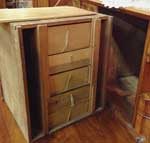We may receive a commission when you use our affiliate links. However, this does not impact our recommendations.
 by Megan Fitzpatrick
by Megan Fitzpatrick
pg. 6
When I was a kid, my mom dragged me to antique malls and furniture auctions on what felt at the time like a daily basis (it was probably four times per year). I would entertain myself on these seemingly interminable occasions by searching the case pieces for hidden drawers and compartments. I’m sure the dealers loved having some snot-nosed kid poking around in their stuff.
I knew early on that the most likely place for hidden drawers was in the center gallery section of a desk or secretary. I could usually tell if there was a “secret” by sticking my hand inside the central cavity to see if the assembly moved at all – a dead giveaway one could pull it out (also a quick way to get the owner to come running). And panels on desktops that slide back to reveal a cavity (sometimes with drawers)? Those, thanks to telltale scratches in the finish on old pieces, were pretty easy to uncover.
It took me a little longer to realize there are often little drawers hidden behind the visible ones on either side of center, and that sometimes the scrollwork on a pigeonhole slides out to reveal a small tray attached behind.
Hollow lopers? A dealer showed me that trickery.
From the November 2016 issue, #228

Here are some supplies and tools we find essential in our everyday work around the shop. We may receive a commission from sales referred by our links; however, we have carefully selected these products for their usefulness and quality.








